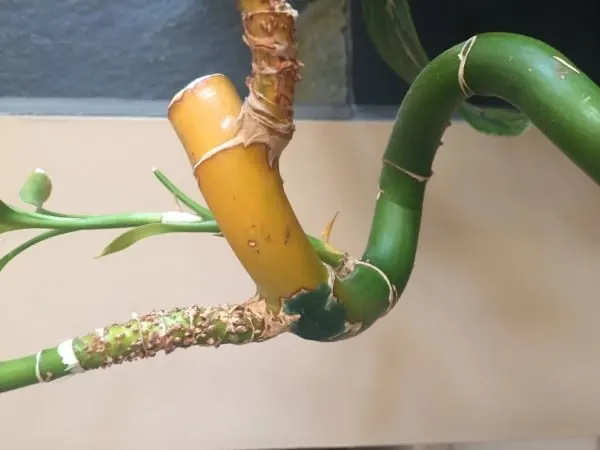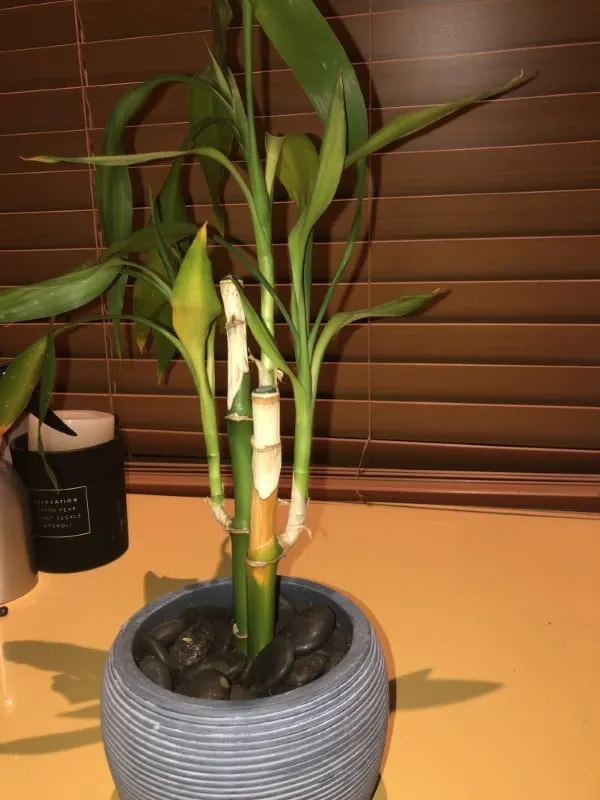Why is my bamboo stem turning yellow? First of all, cool down! I know it can be quite nerve-racking to see your bamboo plants turning yellow, but I’m here to help you get to the root of the issue. What makes me so confident I can help you out with your case? Well, the fact I’ve been where you are.
I remember three years ago how I struggled to care for my first bamboo house plant sufficiently. All I thought at the time was, “Water it, and it will grow.” Needless to say, I couldn’t be further from the truth. At first, my bamboo plant started getting yellow leaves, and before I knew it, it had yellow stems.
The good news is I eventually learned to take better care of my plant after that, and I’ve shared all the tricks and tips I learned back then in this detailed guide.

Why is My Bamboo Stem Turning Yellow?
So, why would your bamboo’s stem be turning yellow? There are several reasons, including insects infestation, root rot, low humidity, over-fertilizing, underwatering, overwatering, and more. Let’s take a look at these reasons in more detail.
Insect Infestation
A yellow stalk on a bamboo plant can be caused by insect infestations, although this rarely happens. The most common pests you should be wary of include mealybugs and mites, as they’re known to suck out all juices off your plant and cause serious (often irreversible) damage.
What’s more? Most of these insects act as breeding grounds for fungi. Once the fungus starts growing on your bamboo plant’s leaves, you might notice brown or black spots.
So, how do you revive a bamboo plant with yellow stems due to insect infestations?
Needless to say, you’ll need to start by getting rid of the pests. In case of mild damage, get rid of the pests by wiping your bamboo plant using a mix of water and soap. You can replace water with an alcohol solution for better success.
In severe cases of infestations, treat your plants using an insecticide. Do not forget to clean the pebbles and vase if you grow your bamboo in water.
Low Humidity
Low humidity could also be the culprit behind the yellowing of your bamboo’s stems and leaves.
When the environs around your bamboo plant become drier, water quickly starts evaporating through the bamboo plant’s leaves, and if you do not do anything to make up for this deficit, your bamboo plant might begin turning yellow. As a general rule of thumb, bamboos need approx.40 to 50 percent moisture.
Regarding how you can increase moisture around your bamboo plant, there are several tricks you can employ. For instance, you can either spray the bamboo with water regularly throughout the day or invest in a humidifier. If you pick the first solution (spraying), note that it could also lead to the emergence of fungus.
With that in mind, carefully and repeatedly example your plant during your spraying sessions to improve your chances of spotting any problem that pops up early on.

Lighting
Another probable reason your bamboo plants’ stems are turning yellow could be direct sunlight hitting the plants. These plants react exceptionally negatively when exposed to direct sunlight. If lighting is the issue, you’ll notice yellow spots appearing on the plant’s leaves and entire leaves turning yellow.
Regarding how you can fix this, you only need to remove the bamboo plant from direct sunlight right away, lest it dies. Instead, place the bamboo plant on a kitchen or work table as these plants prefer diffused lighting. Even artificial light is sufficient for bamboo plants.
Fertilizer
Excessively fertilizing bamboo plants leads to a buildup of excess salts and minerals, resulting in the yellowing of the bamboo plant’s leaves. Overfertilization does this by significantly harming beneficial microorganisms in the bamboo’s soil and making nutrients less available to your bamboo plants.
Even worse, a wide array of fertilizers, particularly those containing nitrogen, promote plants’ sudden growth with undeveloped roots.
With all this in mind, you’re recommended to fertilize your bamboo plants no more than once every month. Even more, if you’re growing your bamboo plants in water, never fertilize them more than once every six months.
If the reason your current bamboo plant turned yellow had to do with overfertilization, all you ought to do is change the water in the container and carefully rinse the container to get rid of any mineral substances that could be stuck to its walls.
Temperature
Bamboo plants tend to thrive in temperatures between 65 Degrees F and 95 Degrees F. If the temperatures drop below 65 degrees F in the room you’ve placed your bamboo plant, then chances are the plants will begin to die. The yellowing of the stems is usually the first sign of this.
Drafts, particularly cold ones, also have the potential to turn bamboo plant leaves yellow.
Over and Under Watering
If you’ve grown your bamboo plants in soil, ensure you water them the needed amount since overwatering is a relatively common cause of yellow stems on bamboo. How do you know its time to water your bamboo plant? Well, perform the soil test.
To do this, feel the soil’s surface using your finger. If the soil appears dry to you, you can safely water your bamboo. If it’s still wet in any sense of the word, wait until the soil is dry before watering again.
Like overwatering, underwatering can also adversely affect your bamboo plant and cause its stem to start turning yellow. The same soil test I’ve detailed above should help you note when you’re underwatering your bamboo plant.
Final Thoughts
Growing bamboos is easy and fun. The most exciting aspect of having one of these plants in your home is witnessing how quickly and beautifully it grows.
As such, if you notice your bamboo’s leaves or stems are turning yellow, try some of the suggestions I’ve shared above to get your beloved house plant back on track.
